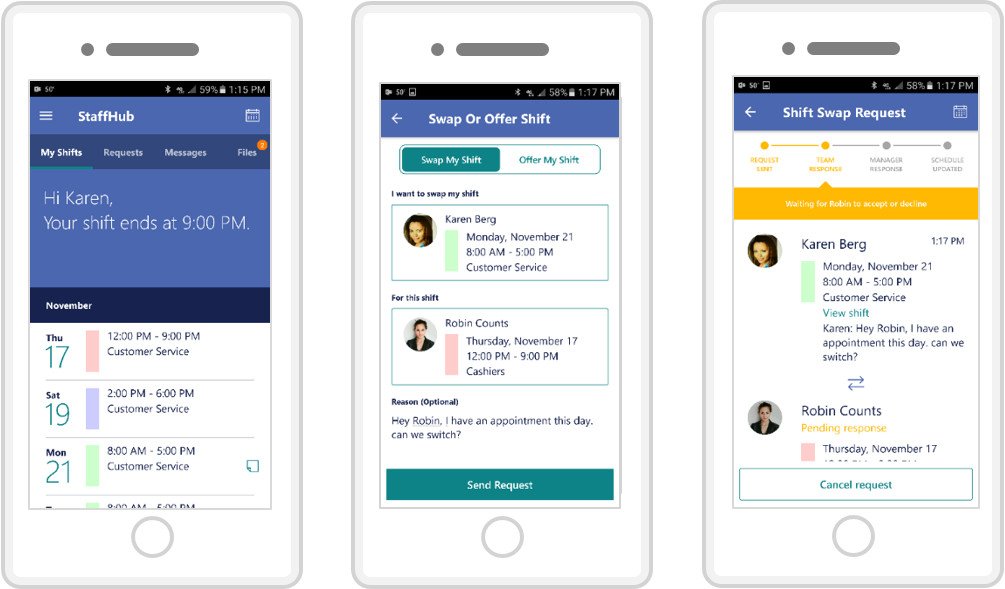StaffHub app for Android, iOS connects workers' smartphones to Microsoft's cloud
Microsoft's cloud strategy reaches millions of low-wage consumers through their smartphones and an app called StaffHub.


Microsoft's General Manager of Design, Research and Product Incubation, Jon Friedman, realized 650 million smartphone-carrying frontline workers weren't connected to Microsoft's cloud. So he did something about it.
Friedman, in an amusing yet informative and self-deprecating talk at Microsoft's Build 2018 developer conference, shared his many failures and few successes since joining Microsoft.
Through his struggles, Friedman realized many thriving businesses using Microsoft 365, the company's AI-connected cloud-based products and services, had wholly excluded low-wage frontline workers from the benefits of Microsoft 365.
This exclusion was also a missed opportunity to bring these workers, who are also smartphone consumers, or dual users (a resource in their own right), into Microsoft's ever-expanding intelligent cloud. Friedman saw an opportunity where Microsoft, "frontline" workers and the company's business partners could all benefit by leveraging the one tool even low-wage workers have: smartphones.
Microsoft 365 misses millions of frontline workers
Many companies using Microsoft 365 and other Microsoft tools reported to Friedman that their "deskless" employees had no use for the products Microsoft was designing for businesses. (See the above video.)
These workers include waiters, hospitality, construction, airline workers and more. A staggering 650 million employees belong to this class of workers within large enterprises, Friedman said. In fact, they make up a larger portion of the workforce than employees that work at desks. Friedman admitted Microsoft had ignored this demographic.
This oversight was reflected in the reality that many companies using Microsoft's cutting-edge AI-driven Microsoft 365 to manage operations were also using bulletin boards littered with push pins and papers to manage schedules, learn and complete tasks, and communicate with frontline workers. These were three areas Microsoft and frontline workers, who are also smartphone consumers, had the resources to address.
All the latest news, reviews, and guides for Windows and Xbox diehards.
Friedman found that many frontline workers making around $10 an hour, or less, also owned $600 smartphones. He saw the pervasive nature of this tool as an opportunity. For instance, Microsoft had previously supplied Microsoft 365 enterprise customers, like Starbucks, with an Office 365 that could be used in a kiosk where employees could check email.
Additionally, managers of various companies used Excel to compose schedules which were ultimately printed and pinned to a board that employees copied or photographed so they would know their schedules. Friedman realized a smartphone app could perform all of the scheduling, task completion, and communication functions that frontline workers had relied on those archaic tools to perform.
So he and his team created StaffHub.
StaffHub brings consumer's phones to the cloud
StaffHub is available on iOS and Android and connects frontline workers to the benefits Microsoft 365 affords the company's enterprise customers. From Microsoft:
Microsoft StaffHub is a cloud-based platform that slips work (and the tools to manage it) into everyone's back pocket. With Microsoft StaffHub, first-line workers can view schedules, swap shifts, and request time off. Managers can create schedules, approve requests, and share information.
One manager reported that StaffHub saves her about a week's worth of time each month and said messaging is the most used function among workers.
StaffHub is yet another bridge between Microsoft's cloud and the average smartphone consumer. And it is available to customers that have an Office 365 Enterprise F1, E1, E3, E5, or Education subscription plan, according to Microsoft.

Jason L Ward is a Former Columnist at Windows Central. He provided a unique big picture analysis of the complex world of Microsoft. Jason takes the small clues and gives you an insightful big picture perspective through storytelling that you won't find *anywhere* else. Seriously, this dude thinks outside the box. Follow him on Twitter at @JLTechWord. He's doing the "write" thing!


